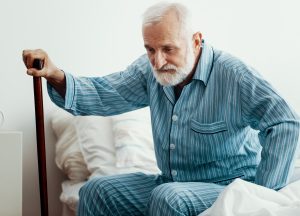Restless Legs Syndrome (RLS) is a neurologic and sleep-related condition characterized by an irresistible urge to move the legs. The symptoms respond to dopaminergic medications such as dopamine agonists or levodopa, which are also used to treat Parkinson’s disease (PD), making an association between RLS and PD likely. Here we explore RLS and its potential connections with PD.
What is Restless Leg Syndrome (RLS)?
Characteristics of Restless Leg Syndrome
There are certain features of RLS that make it a unique and specific disorder.

- The hallmark of RLS is a feeling of restlessness, usually in the legs. The restlessness is often accompanied by additional sensations such as tingling, “creepy-crawly” or electric sensations, usually located in the legs. The symptoms are usually not restricted to the toes or feet, as in peripheral neuropathy, but rather are present more generally in the legs, often the calves or thighs.
- The restlessness is worse when the person is at rest or not moving. This feature makes it hard for people with RLS to get to sleep and can also interfere with the ability to sit still in order to read, relax, or do desk work.
- Symptoms are improved with moving, particularly walking. Unfortunately, the relief lasts only as long as the movement continues, which makes some people “pace the floor” for hours when the condition is severe. Besides walking, sometimes providing other stimuli to the legs is helpful, such as rubbing, massage, or stretching.
- RLS symptoms usually occur in the evening and night and are absent in the daytime. This is the reason that RLS is considered a sleep disorder. If the symptoms are present in the daytime, the intensity of the sensations are usually less than in the evening and night. Most people with the condition have the onset of the feeling in the hours after dinner and before bedtime. The restlessness might impede the onset of sleep or cause the person to wake up frequently, but usually the restlessness goes away during the latter portion of the night and is gone by morning. RLS can cause significant sleep deprivation and anxiety related to trying to fall asleep — and poor sleep can have significant ramifications on health and wellbeing.
- RLS can be accompanied by a related disorder called Periodic Limb Movements of Sleep (PLMS) which are repetitive leg movements that occur during sleep.
Causes of Restless Leg Syndrome
- Although the cause of RLS in many people remains unknown, about half of people with RLS have a family history of the condition. Despite this, no specific gene has been identified.
- RLS can also be secondary to other medical conditions such as iron deficiency, neuropathy and renal failure.
Parkinson’s & Restless Leg Syndrome: Using Dopaminergic Medication
Because RLS is well-treated by medications that also treat PD, it is likely that some aspect of brain dopamine function is altered in RLS. However, unlike in PD, in which the deficit in substantia nigra dopamine-producing cells can be proven in many ways, no such abnormality has been shown in RLS. For example, studies show that DaTscan results are not abnormal in RLS.
Using dopaminergic medications to treat RLS however can be tricky. In some people they can lead to a phenomenon known as augmentation, in which long term use of dopaminergic medications can worsen the symptoms – making them appear earlier in the day or migrating to the upper body in addition to the legs.
Does having RLS increase the risk of developing PD?
Since RLS affects as much as 4-10% of the US adult population, it is clear that the vast majority of those with RLS do not ever develop PD.
Despite this, it still might be the case that RLS increases the risk of subsequently developing PD. There have been many studies trying to figure this out – with conflicting results. Some studies show that there is no increased risk and others show that having RLS confers about a two-fold increased risk of developing PD over the general population.
Is RLS more common in PD?
But what about the other possibility? Do patients with PD have an increased risk of RLS over the general population? Is it the same RLS as the person without PD has, or is it different? These questions have been difficult to answer. Of course, since PD affects about 1.5% of the elderly, and RLS in about 4-10% of the population, there will be some coincidental overlap. In addition to this however, patients with PD can have sensations that feel like RLS when their dose of dopamine medication is wearing off. These sensations are not truly RLS since they do not have the key features of RLS described above (more common at night, improves with movement, etc) and fluctuate with medication timing, but they can be easily confused with RLS by the person with PD.
Studies of people with PD that assess for RLS and compare to a control group are hindered by the fact that the majority of patients with significant PD are under treatment with medications that affect RLS. Over the years, there have been multiple studies investigating whether RLS is more common in PD than in the general population. Different studies come to different conclusions. Studies conducted in which a group of people with PD are directly compared to a group of people without PD (case-control study) typically show that RLS is more common in PD than the general population.
To complicate matters, some researchers of this topic explain that the experience of people with PD is not actually RLS but rather something else called leg motor restlessness (LMR). The difference between the two is that RLS is worse when the legs are not moving and temporarily relieved by movement whereas leg motor restlessness is not worse when the legs are not moving and not relieved by movement. LMR may be increased in people with PD, whereas true RLS may not be.
Treatment of RLS in PD
Regardless of the above discussion, it is clear that many people with PD have difficulty falling asleep because of annoying sensations in the legs accompanied by a sometimes unbearable sense of restlessness in the legs. For these people, taking dopamine agonists before bed can be helpful. Caution is in order, of course, because in some patients with PD, especially older or more advanced patients, these medications can cause confusion and hallucinations and are thus not well-tolerated. A long-acting levodopa formulation or medications such as gabapentin, gabapentin enacarbil and pregabalin can also be effective. Trying to address sleep issues such as RLS in patients who have sleep complaints can be an important aspect of maximizing therapy for PD.
Tips and Takeaways
- Restless leg syndrome (RLS) causes a feeling of restlessness in the evening hours, usually in the legs, when the limbs are at rest. The restlessness is relieved by movement.
- RLS is a common condition in the general population and may have an increased incidence among people with PD, but studies have been inconsistent.
- Dopamine agonists, levodopa, gabapentin, gabapentin enacarbil, and pregabalin, can be tried to help relieve RLS symptoms, but should be used with caution (as with all medications) due to potential side effects.
- Sleep disorders including RLS are very common in PD and often interfere with getting a restful night sleep. Poor sleep can have significant impacts on your health and wellbeing, so talk with your doctor about these symptoms or any symptoms that interfere with your sleep.
This page was adapted from content originally written by Dr. J Steven Poceta, neurologist and sleep medicine specialist.

